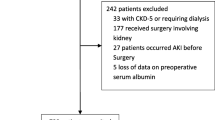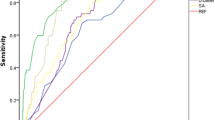Abstract
Background
Perioperative hypoalbuminemia has a prognostic effect on mortality and morbidity in various cohorts. Patients undergoing open repair of ruptured abdominal aortic aneurysms (rAAA) are at a high risk of hypoalbuminemia due to bleeding and underlying diseases. Hence, this study aimed to investigate the predictive value of immediate postoperative hypoalbuminemia for the risk for acute kidney injury (AKI) in patients undergoing open rAAA repair.
Methods
We retrospectively reviewed 143 patients who underwent open rAAA repair between January 2008 and May 2022. The patients were divided into two groups according to the presence of postoperative AKI. The perioperative serum albumin levels of the two groups were compared. The patients were further divided into two groups based on the median immediate postoperative albumin level (2.4 g/dL). The incidence of AKI was compared between the two groups. Multivariate logistic regression analysis was performed to assess the predictors of postoperative AKI. Kaplan-Meier survival curves were used to evaluate potential of AKI and albumin level as prognostic factors for mortality.
Results
Immediate postoperative serum albumin was significantly lower in the AKI group than in the non-AKI group (2.11 ± 0.62 g/dL vs. 2.59 ± 0.62 g/dL, p < 0.001). The incidence of postoperative AKI was significantly higher in patients with albumin ≤ 2.4 g/dL than in patients with albumin > 2.4 g/dL (53.8% vs. 27.7%, p = 0.002). Immediate postoperative albumin level was an independent predictor of AKI (Odds ratio [OR], 0.310; 95% confidence interval [CI] 0.165–0.583, p < 0.001) and 1-year mortality (OR, 0.230; 95% CI 0.098–0.542, p = 0.001).
Conclusions
Immediate postoperative hypoalbuminemia was associated with postoperative AKI and mortality in patients with rAAA.



Similar content being viewed by others
References
Kopolovic I, Simmonds K, Duggan S, Ewanchuk M, Stollery DE, Bagshaw SM (2013) Risk factors and outcomes associated with acute kidney injury following ruptured abdominal aortic aneurysm. BMC Nephrol 14:99
van Beek SC, Legemate DA, Vahl A et al (2014) Acute kidney injury defined according to the “Risk”, “Injury”, “Failure”, “Loss”, and “End-stage” (RIFLE) criteria after repair for a ruptured abdominal aortic aneurysm. J Vasc Surg 60(5):1159–1167
Jalalzadeh H, Indrakusuma R, Vogt L et al (2017) Long-term survival after acute kidney injury following ruptured abdominal aortic aneurysm repair. J Vasc Surg 66(6):1712–1718
Ambler GK, Coughlin PA, Hayes PD, Varty K, Gohel MS, Boyle JR (2015) Incidence and outcomes of severe renal impairment following ruptured abdominal aortic aneurysm repair. Eur J Vasc Endovasc Surg 50(4):443–449
Vincent JL, Dubois MJ, Navickis RJ, Wilkes MM (2003) Hypoalbuminemia in acute illness: is there a rationale for intervention? A meta-analysis of cohort studies and controlled trials. Ann Surg 237(3):319–334
Jantti T, Tarvasmaki T, Harjola VP et al (2019) Hypoalbuminemia is a frequent marker of increased mortality in cardiogenic shock. PLoS ONE 14(5):e0217006
Fleck A, Raines G, Hawker F et al (1985) Increased vascular permeability: a major cause of hypoalbuminaemia in disease and injury. Lancet 1(8432):781–784
Wiedermann CJ, Joannidis M (2015) Nephroprotective potential of human albumin infusion: a narrative review. Gastroenterol Res Pract 2015:912839
Dixon R, Brunskill NJ (1999) Activation of mitogenic pathways by albumin in kidney proximal tubule epithelial cells: implications for the pathophysiology of proteinuric states. J Am Soc Nephrol 10(7):1487–1497
Wiedermann CJ, Wiedermann W, Joannidis M (2017) Causal relationship between hypoalbuminemia and acute kidney injury. World J Nephrol 6(4):176–187
Aksoy R, Adademir T, Yilmaz E et al (2019) Is hypoalbuminemia a predictor for acute kidney injury after coronary bypass grafting in diabetes mellitus patients? Braz J Cardiovasc Surg 34(5):565–571
Li N, Qiao H, Guo JF et al (2019) Preoperative hypoalbuminemia was associated with acute kidney injury in high-risk patients following non-cardiac surgery: a retrospective cohort study. BMC Anesthesiol 19(1):171
Kim K, Bang JY, Kim SO, Kim S, Kim JU, Song JG (2018) Association of preoperative hypoalbuminemia with postoperative acute kidney injury in patients undergoing brain tumor surgery: a retrospective study. J Neurosurg 128(4):1115–1122
Kellum JA, Lameire N (2013) Diagnosis, evaluation, and management of acute kidney injury: a KDIGO summary (Part 1). Crit Care 17(1):204
Doweiko JP, Nompleggi DJ (1991) The role of albumin in human physiology and pathophysiology, Part III: albumin and disease states. JPEN J Parenter Enteral Nutr 15(4):476–483
Soeters PB, Wolfe RR, Shenkin A (2019) Hypoalbuminemia: pathogenesis and clinical significance. JPEN J Parenter Enteral Nutr 43(2):181–193
Kim HJ, Koh WU, Kim SG et al (2016) Early postoperative albumin level following total knee arthroplasty is associated with acute kidney injury: a retrospective analysis of 1309 consecutive patients based on kidney disease improving global outcomes criteria. Medicine (Baltimore) 95(31):e4489
Shin KH, Han SB (2018) Early postoperative hypoalbuminemia is a risk factor for postoperative acute kidney injury following hip fracture surgery. Injury 49(8):1572–1576
Wiedermann CJ, Wiedermann W, Joannidis M (2010) Hypoalbuminemia and acute kidney injury: a meta-analysis of observational clinical studies. Intensive Care Med 36(10):1657–1665
Yu M-y, Lee SW, Baek SH et al (2017) Hypoalbuminemia at admission predicts the development of acute kidney injury in hospitalized patients: a retrospective cohort study. PLoS ONE 12(7):e0180750
Lee EH, Baek SH, Chin JH et al (2012) Preoperative hypoalbuminemia is a major risk factor for acute kidney injury following off-pump coronary artery bypass surgery. Intensive Care Med 38(9):1478–1486
Margarson MP, Soni N (1998) Serum albumin: Touchstone or totem? Anaesthesia 53(8):789–803
Brinkman R, HayGlass KT, Mutch WA, Funk DJ (2015) Acute kidney injury in patients undergoing open abdominal aortic aneurysm repair: a pilot observational trial. J Cardiothorac Vasc Anesth 29(5):1212–1219
Lee EH, Kim WJ, Kim JY et al (2016) Effect of exogenous albumin on the incidence of postoperative acute kidney injury in patients undergoing off-pump coronary artery bypass surgery with a preoperative albumin level of less than 4.0 g/dL. Anesthesiology 124(5):1001–1011
Delaney AP, Dan A, McCaffrey J, Finfer S (2011) The role of albumin as a resuscitation fluid for patients with sepsis: a systematic review and meta-analysis. Crit Care Med 39(2):386–391
Wiedermann CJ, Dunzendorfer S, Gaioni LU, Zaraca F, Joannidis M (2010) Hyperoncotic colloids and acute kidney injury: a meta-analysis of randomized trials. Crit Care 14(5):R191
Perner A, Haase N, Guttormsen AB et al (2012) Hydroxyethyl starch 130/0.42 versus Ringer’s acetate in severe sepsis. N Engl J Med 367(2):124–134
Myburgh JA, Finfer S, Bellomo R et al (2012) Hydroxyethyl starch or saline for fluid resuscitation in intensive care. N Engl J Med 367(20):1901–1911
Futier E, Garot M, Godet T et al (2020) Effect of hydroxyethyl starch versus saline for volume replacement therapy on death or postoperative complications among high-risk patients undergoing major abdominal surgery: the flash randomized clinical trial. JAMA 323(3):225–236
Nagore D, Candela A, Bürge M et al (2021) Hydroxyethyl starch and acute kidney injury in high-risk patients undergoing cardiac surgery: a prospective multicenter study. J Clin Anesth 73:110367
Author information
Authors and Affiliations
Corresponding author
Ethics declarations
Conflict of interest
The authors declare no conflicts of interests.
Ethical approval
This study was approved by institutional review board of Yonsei University Health System (Protocol No.3-2022-0428). The need for informed consent was waived because of the retrospective nature.
Additional information
Publisher's Note
Springer Nature remains neutral with regard to jurisdictional claims in published maps and institutional affiliations.
Rights and permissions
Springer Nature or its licensor (e.g. a society or other partner) holds exclusive rights to this article under a publishing agreement with the author(s) or other rightsholder(s); author self-archiving of the accepted manuscript version of this article is solely governed by the terms of such publishing agreement and applicable law.
About this article
Cite this article
Yoon, H.J., Kim, TH., Ko, D.E. et al. Postoperative Hypoalbuminemia as a Predictor of Acute Kidney Injury After Open Repair of Ruptured Abdominal Aortic Aneurysm. World J Surg 47, 3382–3393 (2023). https://doi.org/10.1007/s00268-023-07178-z
Accepted:
Published:
Issue Date:
DOI: https://doi.org/10.1007/s00268-023-07178-z




